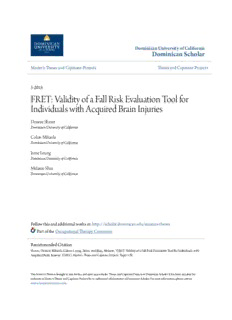
FRET: Validity of a Fall Risk Evaluation Tool for Individuals with Acquired Brain Injuries PDF
Preview FRET: Validity of a Fall Risk Evaluation Tool for Individuals with Acquired Brain Injuries
DDoommiinniiccaann SScchhoollaarr Graduate Master's Theses, Capstones, Student Scholarship and Culminating Projects 5-2015 FFRREETT:: VVaalliiddiittyy ooff aa FFaallll RRiisskk EEvvaalluuaattiioonn TTooooll ffoorr IInnddiivviidduuaallss wwiitthh AAccqquuiirreedd BBrraaiinn IInnjjuurriieess Desiree Shaver Dominican University of California Colon Mikaela Dominican University of California Irene Leung Dominican University of California Melanie Shea Dominican University of California https://doi.org/10.33015/dominican.edu/2015.OT.05 Survey: Let us know how this paper benefits you. Recommended Citation Shaver, Desiree; Mikaela, Colon; Leung, Irene; and Shea, Melanie, "FRET: Validity of a Fall Risk Evaluation Tool for Individuals with Acquired Brain Injuries" (2015). Graduate Master's Theses, Capstones, and Culminating Projects. 139. https://doi.org/10.33015/dominican.edu/2015.OT.05 This Master's Thesis is brought to you for free and open access by the Student Scholarship at Dominican Scholar. It has been accepted for inclusion in Graduate Master's Theses, Capstones, and Culminating Projects by an authorized administrator of Dominican Scholar. For more information, please contact [email protected]. FRET: Validity of a Fall Risk Evaluation Tool for Individuals with Acquired Brain Injuries Mikaela Conlon Irene Leung Desiree Shaver Melanie Shea A Culminating Project Submitted in Partial Fulfillment of the Requirements for the Degree of Master of Science Occupational Therapy School of Health and Natural Sciences Dominican University of California San Rafael, California December 2014 ii This project, written under the direction of the candidates’ faculty advisor and approved by the chair of the Master’s program, has been presented to and accepted by the Faculty of the Occupational Therapy department in partial fulfillment of the requirements for the degree of Master of Science in Occupational Therapy. The content, project, and research methodologies presented in this work represent the work of the candidates alone. Mikaela Conlon, Candidate Date: 12/12/14 Irene Leung, Candidate Date: 12/12/14 Desiree Shaver, Candidate Date: 12/12/14 Melanie Shea, Candidate Date: 12/12/14 Ruth Ramsey, EdD, OTR/L, Chair Date: 12/12/14 Kitsum Li, OTD, OTR/L, Faculty Advisor Date: 12/12/14 iii © Copyright by Mikaela Conlon, Irene Leung, Desiree Shaver, Melanie Shea All Rights Reserved. iv Acknowledgements We would like to thank all of those who have help contribute to our successful completion of our Capstone Project. First and foremost we would like to thank all participants who out of the kindness of their heart, participated in our research study. We would like to thank our Capstone advisor, Dr. Kitsum Li, for her support, guidance, and expert advice. Additionally we would like to thank her for the countless hours she has spent reviewing our written work and research. We would also like to thank Mark McAlister for the many hours he spent with us compiling and analyzing our data. Without his guidance and support we could not have completed our research analysis. We would like to give a special thanks to Kim Schoessow for her continual and editorial support throughout this process. We would like to thank the Brain Injury Network of the Bay Area for assisting with recruitment of participants for this study. In addition, we thank the Brain Injury Network of the Bay Area and Peninsula Stroke Association allowing us to utilize their facility to conduct assessments. We would also like to thank Dominican University of California for providing us financial assistance to present our Capstone poster at the Occupational Therapy Association of California conference in Pasadena, CA. Lastly we would like to thank our cohort, friends, and family for all their patience, support, and encouragement throughout our time at Dominican University of California. v Table of Content Content Page Introduction………………………………………………………………………………..1 Statement of Problem………………………………………………………………...........2 Literature Review………………………………………………………………………….2 Falls and the Acquired Brain Injury……………………………………………....2 Fall Risk Factors……………………………………………………………..........4 Fall Risk Assessments………………………………………………...……..........7 Assessments……………………………………………………………….………8 Validity…………………………………………………………………………….…….11 The Fall Risk Evaluation Tool (FRET)…………………………………………….........12 Summary…………………………………………………………………………………13 Statement of Purpose……………………………………………………………….........14 Theoretical Framework…………………………………………………………….…….14 Person-Environment-Occupation…………………………………………...........14 Definitions……………………………………………………………………….….........16 Methodology……………………………………………………………………………..17 Design……………………………………………………………………............17 Subjects…………………………………………………………………………..18 Data Collection…………………………………………………………………..19 Data Analysis……………………………………………………………….........21 Limitations……………………………………………………………………….………22 Ethical and Legal Considerations………………………………………………….…….22 vi Results……………………………………………………………………………………24 Discussion………………………………………………………………………………..26 Conclusion………………………………………………………………………….........28 vii List of Tables Table Page Table 1: Participants’ Demographics ……………………………………………..…… 30 Table 2: FRET Scores…………………………………………………………..……... 30 Table 3: 2013 FRET Study……..…………………………………………………….… 31 viii Appendix Appendix Page FRET assessment (Appendix A)……………………………………………………...….32 Saint Louis University Mental Status Examination (SLUMS) (Appendix B)……….......33 Flyers (Appendix C)…………………………………………………………………..…34 Craigslist posting (Appendix D)…………………………………………………………35 Informed Consent Document (Appendix E)…………………………………………..…36 Participants’ Bill of Rights (Appendix F)…………………………………………….….38 Proxy Consent Form (Appendix G)…………………………………………………..….40 Proxy Bill of Rights (Appendix H)………………………………………………………42 Demographic Form (Appendix I)………………………………………………………..44 “Fall Prevention” packet (Appendix J)…………………………………………………..45 Fall Calendars (Appendix K)………………………………………………………...…..57 Standardized Phone Call Script (Appendix L)…………………………………………...58 IRB Approval (Appendix M)…………………………………………………………….59 ix Abstract Objective: The purpose of this study is to evaluate the predictive validity of the Fall Risk Evaluation Tool (FRET) for individuals with acquired brain injuries (ABIs). Methods: Ten participants were included for the study. Inclusion criteria for participants included: age 18 and older, English speaking, 6-months post ABI, ambulatory with or without an assistive device, and uses a wheelchair less than 25% of the day. Exclusion criteria for participants included: global confusion and degenerative neurological conditions. Following the administration of the FRET, participants recorded falls that occurred over the following 3-month study period. Results: Data was analyzed using the Pearson’s r correlation coefficient. No correlation was found between the FRET score and the participants’ reported number of falls during the study period. Correlation between individual subtests within the FRET and actual fall occurrence was also examined. The medication subtest was the only item on the FRET that showed a significant correlation with the participants’ falls. A significant correlation was found between the number of falls during 6-months prior to the study and the fall occurrence during the 3-month study period. Conclusion: There is currently a lack of multi-factorial fall risk assessments specifically designed for individuals with ABIs. The FRET was designed to fill this gap in assessments for individuals with ABIs, although no conclusion can currently be drawn regarding its predictive validity. The study suggests modifications should be made to the FRET to increase the predictive validity the FRET.
Description: